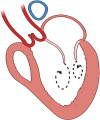Intracardiac fluid dynamic analysis: available techniques and novel clinical applications
- PMID: 39702022
- PMCID: PMC11660877
- DOI: 10.1186/s12872-024-04371-3
Intracardiac fluid dynamic analysis: available techniques and novel clinical applications
Abstract
There is a growing interest in the potential use of intracardiac fluid dynamic analysis to better understand cardiac mechanics and identify novel imaging biomarkers of cardiovascular disease. Abnormalities of vortex formation and shape may in fact play a critical role in cardiac function, affecting both efficiency and myocardial workload. Recent advances in imaging technologies have significantly improved our ability to analyze these dynamic flow patterns in vivo, offering new insights into both normal and pathological cardiac conditions. This review will provide a comprehensive overview of the available imaging techniques for intracardiac fluid dynamics analysis, highlighting their strengths and limitations. By synthesizing the current knowledge in this evolving field, the paper aims to underscore the importance of advanced fluid dynamic analysis in contemporary cardiology and to identify future directions for research and clinical practice.
Keywords: 4d Flow; Cardiac mechanics; Fluid dynamics; Phase contrast magnetic resonance imaging; Vortex.
© 2024. The Author(s).
Conflict of interest statement
Declarations. Ethics approval and consent to participate: Not applicable. Consent for publication: Not applicable. Competing interests: The authors declare no competing interests.
Figures




Similar articles
-
Cardiac fluid dynamics meets deformation imaging.Cardiovasc Ultrasound. 2018 Feb 20;16(1):4. doi: 10.1186/s12947-018-0122-2. Cardiovasc Ultrasound. 2018. PMID: 29458381 Free PMC article. Review.
-
Intracardiac Flow Analysis: Techniques and Potential Clinical Applications.J Am Soc Echocardiogr. 2019 Mar;32(3):319-332. doi: 10.1016/j.echo.2018.10.018. Epub 2019 Jan 14. J Am Soc Echocardiogr. 2019. PMID: 30655024 Review.
-
Tetralogy of Fallot regurgitation energetics and kinetics: an intracardiac flow analysis of the right ventricle using computational fluid dynamics.Int J Cardiovasc Imaging. 2024 May;40(5):1135-1147. doi: 10.1007/s10554-024-03084-0. Epub 2024 Apr 26. Int J Cardiovasc Imaging. 2024. PMID: 38668927
-
Heart blood flow simulation: a perspective review.Biomed Eng Online. 2016 Aug 25;15(1):101. doi: 10.1186/s12938-016-0224-8. Biomed Eng Online. 2016. PMID: 27562639 Free PMC article. Review.
-
Important advances in technology and unique applications related to cardiac magnetic resonance imaging.Methodist Debakey Cardiovasc J. 2014 Jul-Sep;10(3):159-62. doi: 10.14797/mdcj-10-3-159. Methodist Debakey Cardiovasc J. 2014. PMID: 25574343 Free PMC article. Review.
References
-
- Bissell MM, Dall’Armellina E, Choudhury RP. Flow vortices in the aortic root: in vivo 4D-MRI confirms predictions of Leonardo Da Vinci. Eur Heart J. 2014;35(20):1344–1344. - PubMed
-
- Kilner PJ, Yang GZ, Wilkes AJ, Mohiaddin RH, Firmin DN, Yacoub MH. Asymmetric redirection of flow through the heart. Nature. 2000;404(6779):759–61. - PubMed
-
- Pedrizzetti G, La Canna G, Alfieri O, Tonti G. The vortex—an early predictor of cardiovascular outcome? Nat Rev Cardiol. 2014;11(9):545–53. - PubMed
-
- Kheradvar A, Rickers C, Morisawa D, Kim M, Hong GR, Pedrizzetti G. Diagnostic and prognostic significance of cardiovascular vortex formation. J Cardiol. 2019;74(5):403–11. - PubMed
Publication types
MeSH terms
Grants and funding
LinkOut - more resources
Full Text Sources
Medical

